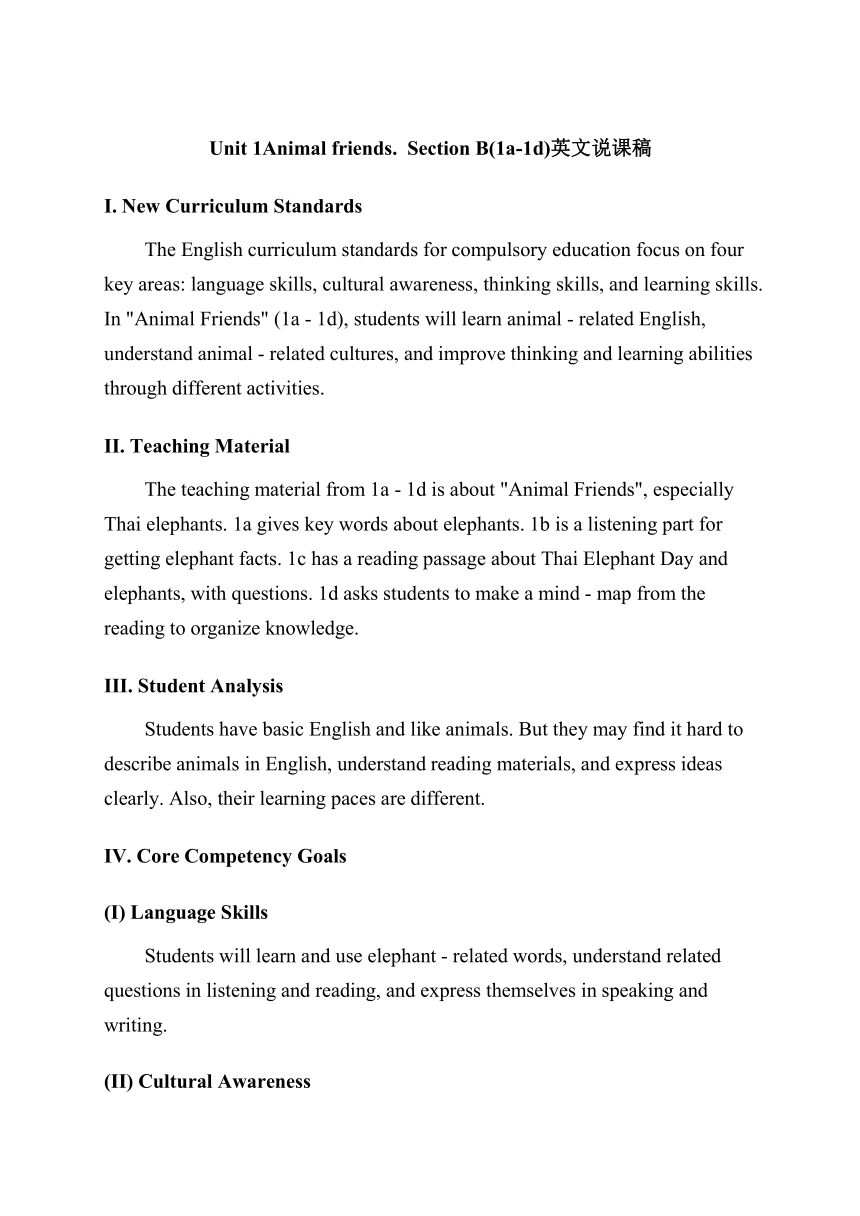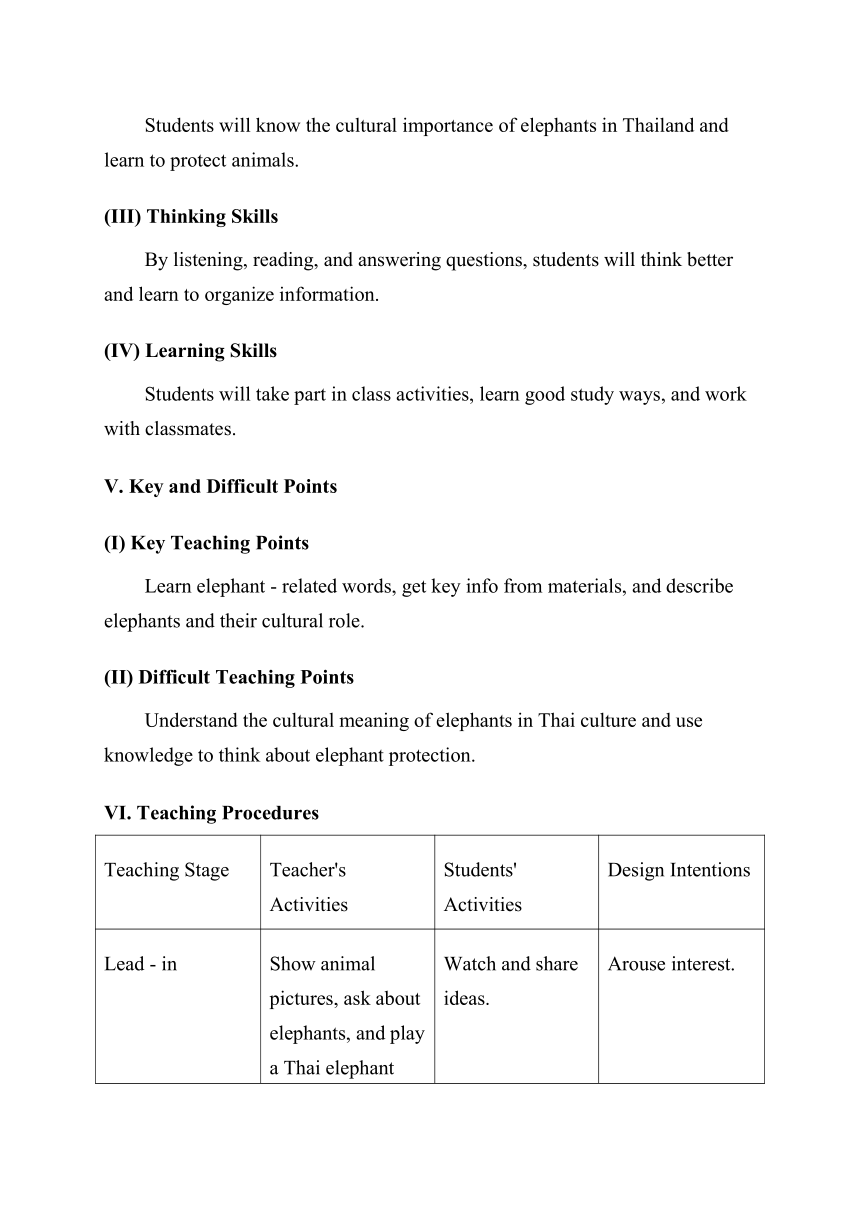Unit 1Animal friends Section B(1a-1d)英文说课稿人教版(2024)七年级英语下册
文档属性
| 名称 | Unit 1Animal friends Section B(1a-1d)英文说课稿人教版(2024)七年级英语下册 |  | |
| 格式 | docx | ||
| 文件大小 | 19.4KB | ||
| 资源类型 | 教案 | ||
| 版本资源 | 人教版 | ||
| 科目 | 英语 | ||
| 更新时间 | 2025-02-20 13:02:09 | ||
图片预览


文档简介
Unit 1Animal friends. Section B(1a-1d)英文说课稿
I. New Curriculum Standards
The English curriculum standards for compulsory education focus on four key areas: language skills, cultural awareness, thinking skills, and learning skills. In "Animal Friends" (1a - 1d), students will learn animal - related English, understand animal - related cultures, and improve thinking and learning abilities through different activities.
II. Teaching Material
The teaching material from 1a - 1d is about "Animal Friends", especially Thai elephants. 1a gives key words about elephants. 1b is a listening part for getting elephant facts. 1c has a reading passage about Thai Elephant Day and elephants, with questions. 1d asks students to make a mind - map from the reading to organize knowledge.
III. Student Analysis
Students have basic English and like animals. But they may find it hard to describe animals in English, understand reading materials, and express ideas clearly. Also, their learning paces are different.
IV. Core Competency Goals
(I) Language Skills
Students will learn and use elephant - related words, understand related questions in listening and reading, and express themselves in speaking and writing.
(II) Cultural Awareness
Students will know the cultural importance of elephants in Thailand and learn to protect animals.
(III) Thinking Skills
By listening, reading, and answering questions, students will think better and learn to organize information.
(IV) Learning Skills
Students will take part in class activities, learn good study ways, and work with classmates.
V. Key and Difficult Points
(I) Key Teaching Points
Learn elephant - related words, get key info from materials, and describe elephants and their cultural role.
(II) Difficult Teaching Points
Understand the cultural meaning of elephants in Thai culture and use knowledge to think about elephant protection.
VI. Teaching Procedures
Teaching Stage Teacher's Activities Students' Activities Design Intentions
Lead - in Show animal pictures, ask about elephants, and play a Thai elephant video. Watch and share ideas. Arouse interest.
Vocabulary Learning Write words on the board, explain with pictures, teach pronunciation, and play a word - matching game. Listen, read, and play. Help learn words.
Listening Practice Play the 1b recording, ask students to circle words and fill blanks, then check answers. Listen, circle, fill, and ask questions. Train listening.
Reading Teaching Let students predict the 1c passage, read twice, discuss in groups, and check answers. Predict, read, discuss, and listen. Improve reading.
Mind - map Completion Explain the 1d mind - map, let students complete it, share, and plete, share, and comment. Develop information - organizing ability.
Summary and Homework Summarize the lesson and assign homework: write about what they learned about elephants. Listen and note the homework. Consolidate knowledge.
VII. Teaching Reflection
Employing pictures and videos at the start of the class effectively aroused students' curiosity and enthusiasm, drawing them into the topic. Group activities like the word - matching game and group discussions not only made the learning process more engaging but also significantly boosted students' participation. It was encouraging to see them collaborating and expressing their ideas with confidence.
However, I became aware of some areas that need improvement. I didn't manage to fully address the diverse learning needs of students. For instance, students with weaker language skills had a tough time understanding complex sentences in the reading material and using new vocabulary accurately. I should have provided more personalized support during class.
Moreover, the exploration of cultural content was rather superficial. Although students were introduced to the cultural significance of elephants in Thai culture, we didn't delve deep enough into the underlying reasons and cultural backgrounds. This led to a relatively shallow understanding among students.
In future classes, I plan to focus more on individual differences. I'll prepare additional materials and offer more one - on - one guidance for students who need extra help. When it comes to cultural teaching, I'll incorporate more in - depth discussions, real - life examples, and cultural stories to enhance students' understanding.
I. New Curriculum Standards
The English curriculum standards for compulsory education focus on four key areas: language skills, cultural awareness, thinking skills, and learning skills. In "Animal Friends" (1a - 1d), students will learn animal - related English, understand animal - related cultures, and improve thinking and learning abilities through different activities.
II. Teaching Material
The teaching material from 1a - 1d is about "Animal Friends", especially Thai elephants. 1a gives key words about elephants. 1b is a listening part for getting elephant facts. 1c has a reading passage about Thai Elephant Day and elephants, with questions. 1d asks students to make a mind - map from the reading to organize knowledge.
III. Student Analysis
Students have basic English and like animals. But they may find it hard to describe animals in English, understand reading materials, and express ideas clearly. Also, their learning paces are different.
IV. Core Competency Goals
(I) Language Skills
Students will learn and use elephant - related words, understand related questions in listening and reading, and express themselves in speaking and writing.
(II) Cultural Awareness
Students will know the cultural importance of elephants in Thailand and learn to protect animals.
(III) Thinking Skills
By listening, reading, and answering questions, students will think better and learn to organize information.
(IV) Learning Skills
Students will take part in class activities, learn good study ways, and work with classmates.
V. Key and Difficult Points
(I) Key Teaching Points
Learn elephant - related words, get key info from materials, and describe elephants and their cultural role.
(II) Difficult Teaching Points
Understand the cultural meaning of elephants in Thai culture and use knowledge to think about elephant protection.
VI. Teaching Procedures
Teaching Stage Teacher's Activities Students' Activities Design Intentions
Lead - in Show animal pictures, ask about elephants, and play a Thai elephant video. Watch and share ideas. Arouse interest.
Vocabulary Learning Write words on the board, explain with pictures, teach pronunciation, and play a word - matching game. Listen, read, and play. Help learn words.
Listening Practice Play the 1b recording, ask students to circle words and fill blanks, then check answers. Listen, circle, fill, and ask questions. Train listening.
Reading Teaching Let students predict the 1c passage, read twice, discuss in groups, and check answers. Predict, read, discuss, and listen. Improve reading.
Mind - map Completion Explain the 1d mind - map, let students complete it, share, and plete, share, and comment. Develop information - organizing ability.
Summary and Homework Summarize the lesson and assign homework: write about what they learned about elephants. Listen and note the homework. Consolidate knowledge.
VII. Teaching Reflection
Employing pictures and videos at the start of the class effectively aroused students' curiosity and enthusiasm, drawing them into the topic. Group activities like the word - matching game and group discussions not only made the learning process more engaging but also significantly boosted students' participation. It was encouraging to see them collaborating and expressing their ideas with confidence.
However, I became aware of some areas that need improvement. I didn't manage to fully address the diverse learning needs of students. For instance, students with weaker language skills had a tough time understanding complex sentences in the reading material and using new vocabulary accurately. I should have provided more personalized support during class.
Moreover, the exploration of cultural content was rather superficial. Although students were introduced to the cultural significance of elephants in Thai culture, we didn't delve deep enough into the underlying reasons and cultural backgrounds. This led to a relatively shallow understanding among students.
In future classes, I plan to focus more on individual differences. I'll prepare additional materials and offer more one - on - one guidance for students who need extra help. When it comes to cultural teaching, I'll incorporate more in - depth discussions, real - life examples, and cultural stories to enhance students' understanding.
同课章节目录
